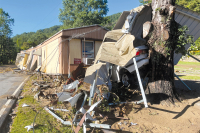What’s all the buzz about Haywood County mosquitoes?
 Citing recent news stories about mosquitoes transmitting the Zika virus, Haywood County Director of Health and Human Services Patrick H. Johnson presented information to the Haywood County Board on Haywood County’s mosquito populations, the risks the insects pose, prevention measures, and available assistance.
Citing recent news stories about mosquitoes transmitting the Zika virus, Haywood County Director of Health and Human Services Patrick H. Johnson presented information to the Haywood County Board on Haywood County’s mosquito populations, the risks the insects pose, prevention measures, and available assistance.
The good news is that Zika — which is transmitted from humans to mosquitoes and then back to humans and can cause severe birth defects — is introduced to an area mostly by travel to another region where the virus is active.
From January 2015 through June 15 of this year, there are no known cases of Zika in Haywood County, although one person was tested, Johnson said. The results came back negative, but there have been 15 reported in North Carolina and 755 in the United States in that time.
The bad news is that the two types of mosquitoes that carry the LaCrosse Encephalitis virus are present in all of Western North Carolina and East Tennessee, and pose what Johnson said is a much more “realistic” health risk.
In 2013, which was the last year data from the Centers for Disease Control and Prevention were available, the Western North Carolina counties of Haywood, Transylvania, Jackson, Swain, and Graham all averaged more than 2.5 cases per 100,000 residents of the so-called “LACE” virus each year since 2004, joining two Tennessee counties and eight West Virginia counties as the most-infected counties in the entire country.
Those at risk for infections spend a lot of time outdoors, live near woodlands or trash-strewn properties, and fail to protect themselves adequately.
Related Items
The LACE virus can cause fatigue, fever, headache, lethargy, vomiting, and seizures and can also lead to brain damage and, in some cases, death. It is passed from animals to mosquitoes and then to humans, and most commonly affects younger people.
“The median age of people who contract it is 8 years old, so it’s a disease of children, it’s a summertime disease,” Johnson said.
As there is no cure, Johnson says that prevention is key, and suggests a “drain, dress, defend” strategy — drain standing water from places it tends to collect, dress in long sleeves and pants, and defend uncovered skin with repellents listing DEET as an ingredient.
“I think people are worried more about ZIka than LaCrosse,” said Johnson, “so if that helps people to drain, dress, and defend, then that’s good.”
Those unable to remediate hazards on their property — especially the elderly and disabled — can seek help from the Haywood County HHS. Additionally, if a neighboring property presents a hazard — because mosquitoes will travel the length of five football fields for a blood meal, Johnson said — residents can call Haywood County Code Enforcement.









